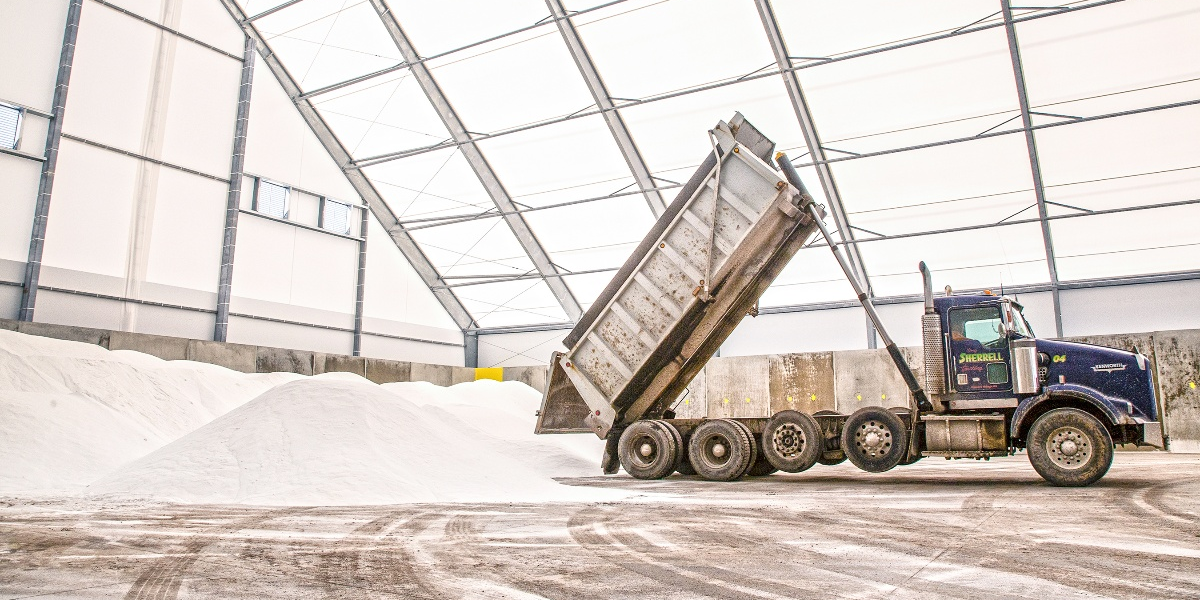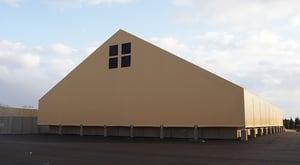Storing Salt the Smart Way

When you need it during a snow event, you need it immediately—and when you store it, its corrosive nature can quickly wear down any structure that isn’t built to handle it.
When the snow flies, Departments of Transportation (DOTs), cities and counties across North America must mobilize quickly to keep roads open and safe. Salt is a critical tool in every snow and ice management plan. Since storms can escalate rapidly, plow operators need fast, reliable access to road salt so they can load up and return to the road without delay.
The rest of the year, protecting your salt supply from wind and moisture is key. Exposure to the elements can reduce salt quality and increase costs. A dedicated storage facility keeps your material dry and usable, while also allowing you to take advantage of off-season bulk discounts—saving taxpayer dollars and ensuring you’re ready for the next storm.
In addition, permanent road salt storage buildings also comply with environmental regulations requiring storage systems that prevent leaching and groundwater pollution. “We are definitely seeing an increase in legislation that protects groundwater from salt run-off,” said Matt Van Scoyoc, Building and Project Design Consultant for Legacy Building Solutions.
See examples of salt storage buildings in action.
3 Factors to consider when designing your salt facility
A well-designed salt storage building should balance capacity, efficiency, and safety. Here are three important considerations:
- Storage capacity – Salt stockpiles expand and shrink throughout the year. Plan for both peak and off-season needs to ensure year-round readiness.
- Loading method – Efficiency matters during a snowstorm. Buildings with clear-span interiors and high clearance allow loaders and trucks to move freely, making loading and unloading faster and safer.
- Fleet size and traffic flow – The number and size of trucks in your operation help determine the best layout for entrances, exits, and drive paths.
 “There’s more to building design than just the size needed,” said Van Scoyoc. “The best salt storage buildings will also be designed with clearance for conveyors and tipping trucks, separate entrances for workers and equipment, and enough lighting to address safety concerns.”
“There’s more to building design than just the size needed,” said Van Scoyoc. “The best salt storage buildings will also be designed with clearance for conveyors and tipping trucks, separate entrances for workers and equipment, and enough lighting to address safety concerns.”
Legacy Building Solutions has decades of experience designing custom salt storage structures for DOTs, public works departments, and private snow-removal operations.
A logical custom-designed building can also eliminate safety concerns by providing clear drive paths and adequate space.
Built to Resist Corrosion
Municipalities across North America understand the value of fabric structures for salt storage. Gone are the days of simply throwing a tarp over a pile—today’s storage buildings must handle highly corrosive environments and stand up for decades of use.
While architectural fabric naturally resists corrosion, not all building frames do. Conventional steel panels and fasteners can deteriorate within just a few years.

We have designed our buildings to combat corrosion in a number of ways:
- Solid steel, rigid-frame structures—never hollow tubes.
- A patented fabric attachment system that minimizes moisture contact points.
- EpoxxiShield™ epoxy coatings that form a complete barrier between salt and steel, outperforming traditional galvanization.
“Legacy buildings are really ideal for salt storage,” said Van Scoyoc. “The fabric, the rigid frame and the ExxoTec™ PVC fabric are all optimized for daily use by municipal and commercial snow removal operations. And of course, the natural light inside a fabric building allows for ongoing energy cost savings.”
A fabric salt storage building is one tool for city, county and state officials to both keep the roads open and protect the taxpayers’ money.
Accordion with Background Color
Legacy designs and installs custom salt storage buildings across the U.S. and Canada. From coastal regions to northern snow belts, our team provides reliable solutions anywhere road salt is needed.
Our rigid steel frames and ExxoTec™ PVC fabric are built to handle snow loads, wind, and extreme temperatures—delivering dependable performance through harsh winter conditions.
Legacy’s EpoxxiShield™ epoxy-coated steel and patented fabric attachment system block moisture and salt contact, extending the life of your building and reducing maintenance.
Yes. Each facility is engineered to your specific needs, including truck size, traffic flow, conveyor clearance, and local snow-load requirements.
Ready to learn how a fabric structure can add efficiencies to your operation? Contact us today.
Subscribe to our Blog
Recent Posts
- Climate Resilience in Commercial Construction: Why Traditional Methods May Not Be Enough
- Speed and Quality: The Role of Hybrid Building Materials
- Beyond the Bleachers: Designing Visually Striking Sports Facilities
- Why Architects Prefer Hybrid Steel Over PEMBs & Traditional Builds
- Building Innovations and Trends in the Mining Industry
